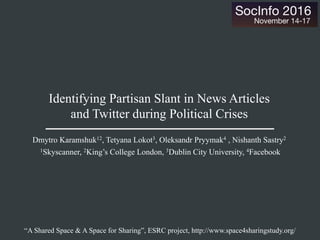
Identifying Partisan Slant in News Articles and Twitter during Political Crises
- 1. Identifying Partisan Slant in News Articles and Twitter during Political Crises Dmytro Karamshuk12, Tetyana Lokot3, Oleksandr Pryymak4 , Nishanth Sastry2 1Skyscanner, 2King’s College London, 3Dublin City University, 4Facebook “A Shared Space & A Space for Sharing”, ESRC project, http://www.space4sharingstudy.org/
- 2. • what are the interrelationships between mainstream media and social networks in shaping public opinion during mass protests and war conflicts • how propaganda and manipulation in the information sphere work • can we identify and characterize media bias in traditional and social media during conflict Identifying partisan slant during political crises
- 3. Use case and datasets Ukrainian Crisis in 2013-2014 • revolution of “dignity”, Nov’13 – Feb’14 • annexation of Crimea and war conflict in Earstern Ukraine, Feb’14 - today
- 4. A headline from a Russian news agency, 2015 “The country is a madhouse, and people in it are patients” RIA News, 2015 In contrast to the brainwashed masses, the leaders of the junta understand that the 150K army of "Ukrainian patriots" resists not Russian troops but 20 thousand local "separatists", complimented with a couple of thousands (or even less) volunteers from nearly a dozen countries around the world, including Russia. The leaders of the junta understand the situation at the front and, in particular, the lack of effective command and control, arbitrariness in the ranks of the National Guard under and Right Sector, the hatred of the population to the law enforcement bodies, but the main thing – horrible morale of the personnel of the Armed Forces of Ukraine, which is expressed in the mass desertion, drunkenness, looting and robbery, which do not reflect the goals of Ukrainian "revolution." https://ria.ru/analytics/20150410/1057804681.html
- 5. Theory of propaganda International Encyclopedia of Propaganda - Cole, R. (Ed.). (1998) - identifies over 40 kinds of propaganda techniques, corroborated in other media literacy and media studies sources. • Ad nauseam (insistent ideas) • Repetition • Demonizing the enemy • “Kind words,” Slogans, Euphoria • Cult of personality • Lingvo propaganda (verbal control) • Assigning labels to events/personas
- 6. Identifying markers of partisan slant Extract and compare semantics of words in different sources using Word2Vec approach
- 7. Predicting slant – Machine learning approach Select top media sources in Ukraine and Russia Manually classify Train supervised learning model • Russian independent • Russian pro-government • Ukrainian • Top-30 Russian online news source • Top-5 Ukrainian online news sources • use text features from news articles as features • predict from a news source of which party it originates
- 8. Problem with this approach We need to make sure that the language patterns we learn are partisan – not source-specific • Exemplar markers of individual news sources
- 9. Identifying markers of partisan slant discourage learning patterns specific to individual news agencies by modifying objective function take-one-source-out cross validation where we test on a news source which was not shown during training Machine Learning results Control for source-specific bias
- 10. An average Twitter user is exposed to a variety of news sources BUT with a clear partisan focus How about Social Media? We can reason about bias in Twitter by looking at news reposts … but, only a small share of users repost news articles
- 11. Predicting political leaning in social media Supervised learning model to identify political leaning of a Twitter user based on the content of his/her Tweets • use content of all tweets (except of news reposts) from a user profile as features • predict leaning based on what they repost There is a reasonable/identifiable difference in posts of Twitter profiles exposed to different partisan media
- 12. Conclusions • We have shown how to measure the difference in word choices in partisan media during conflicts • We trained a supervised machine learning model to recognize media bias in both traditional and social media • Even such “coarse-grain” approach of labelling news agencies can perform reasonably well in identifying political leaning Dmytro Karamshuk follow me on Twitter: @karamshuk
